Ailanthus altissima
By Victoria Wallace, Alyssa Siegel-Miles, and Klaudia Sowizral, UConn Extension
Identifying Features
- OVERVIEW: Tree-of-heaven grows quickly and can ultimately reach up to 80-100’ in height. Allelopathic - chemicals in plant leaves, roots, and bark can limit or prevent the establishment of other plants.
- LEAVES: Pinnately compound (central stem with leaflets attached on each side). Overall leaf ranges in size from 1-4’ in length. Each leaf has 11-41 lance-shaped leaflets, with smooth margins (edges). One to two protruding bumps, called glandular teeth, are at the base of each leaflet. When crushed, the leaves and all plant parts give off a strong, offensive odor.
- STEMS: Alternate on the tree, stout, greenish to brown, and lacking a terminal bud. Stems have large V- or heart-shaped leaf scars. Fuzzy, reddish-brown twigs, which easily break to expose the large, spongy, brown center, or pith.
- BARK: Smooth and green when young, eventually turning light brown to gray, resembling the skin of a cantaloupe.
- FLOWERS/FRUIT: Flowering occurs in late May through early June. Fruits (samaras) hang in clusters, turn from green to dull orange/brown color, and are wind dispersed. Trees are either male or female (dioecious).
- REPRODUCTION/SPREAD: Female trees are prolific seeders, with the potential to produce more than 300,000 seeds annually. Sprouts as young as two years of age are capable of producing seed. Aggressive root suckers also extend the spread as far as 50’from the parent tree, creating dense colonies of established trees.
- Correct identification is critical; some native trees look similar, including staghorn sumac and walnuts. Staghorn sumac is distinguished by its size (10-20’), serrated leaf edges, and upright clusters of small fuzzy fruits. Walnuts produce large nuts and leaves lack glands and foul odor.
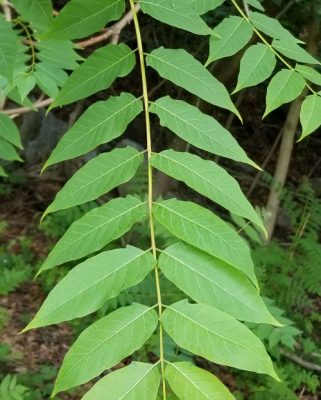

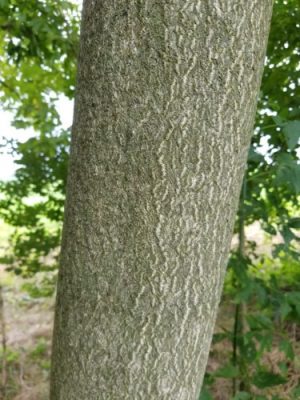

Habitat
Tree-of-heaven is not shade tolerant. It is particularly invasive in urban landscapes, right of ways, roadsides, and woodland edges. It establishes quickly, colonizing primarily disturbed and neglected areas. The plant is resistant to pollution, can tolerate very poor soils, and can even grow in cracks in pavement, building foundations, and other human-created habitats.
Control
MECHANICAL CONTROL: Due to its extensive root system and the ability to aggressively sucker and resprout, eradication of tree-of-heaven is extremely difficult. The correct timing of the treatment, and follow-up maintenance during subsequent years, are critical to eradication success.
- Young seedlings can be pulled by hand, most effectively when the soil is moist. Care must be taken to remove as much of the entire root system as possible, as broken root fragments will re-sprout. Once plants develop a significant taproot, which can occur within 3 months, they become very difficult to remove. Seedlings can be easily confused with root suckers, which are nearly impossible to pull by hand.
- Larger trees may be cut at ground level with power or manual saws. Cutting is most effective when trees have begun to flower (June-early July). A cut or injured tree-of-heaven may send up dozens of root sprouts. At least two cuttings per year may be necessary (one early in the growing season and one late in the growing season) to significantly weaken the plant. Although plants may not be killed after cutting, seed production will be inhibited and vigor will be reduced. If the cutting process is repeated for many years, plants will be severely stressed and will likely eventually die.
- Girdling of the tree trunk may also be an effective method to reduce vigor or kill large trees. A cut through the bark, approximately 6” above the ground, and cut completely around the trunk, will kill the top of the tree. However, re-sprouts are common, and may require follow-up treatments for several years.
CHEMICAL CONTROL: Follow label directions when using all chemical treatments. Below recommendations may require the procurement of a professionally licensed applicator.
- A foliar spray of glyphosate (after mid-August) or a basal bark application of triclopyr (year-round; best in summer) may be effective. Systemic herbicides are most effectively applied in mid- to late summer (until the onset of fall color), when the tree is moving carbohydrates to the roots. Herbicide applications made outside this late growing season window will only injure above-ground growth. Following treatment, repeated site monitoring and treatment of signs of regrowth is critical to prevent reinfestation.
- Herbicides applied to foliage, bark, or frill girdles are effective at controlling tree-of-heaven. Note that cut stump herbicide applications encourage root suckering and are not generally recommended without repeated follow up treatments. Apply all herbicide treatments after July 1, up until the tree begins to show fall color.
- Tree-of-heaven tends to be more susceptible to triclopyr than to glyphosate, especially prior to late summer. Where permitted, foliar sprays are effective once the leaves are fully expanded. For larger trees, three approaches are possible: 1) Girdle the tree (see description above), and apply triclopyr* in the cut around the trunk; 2) Cut down tree and apply triclopyr into the freshly cut surfaces of the stump; or 3) Cut down tree and spray re-sprouts before they get too tall to correctly spray the top surface. Extension.UMD.edu has more in-depth chemical control information.
Well-established tree-of-heaven stands are only eliminated through repeated monitoring and control efforts. Initial treatments often only reduce the root systems, making follow-up measures necessary. Persistence is the key to success.
Distribution
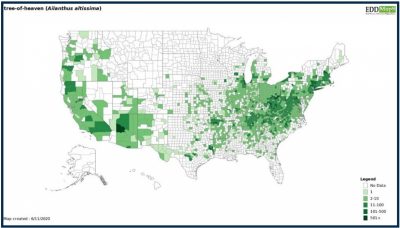
Tree-of-heaven is very common in the Midwest, lower northeast, as well as the west and southwest coast. The plant’s ability to thrive in poor soils has allowed for it to spread throughout much of the US.
Other Facts and Background
Tree-of-heaven is native to China; it was first introduced into the U.S. in the Philadelphia area in 1784. Spotted Lanternfly, an invasive pest, is particularly attracted to tree-of-heaven, making this plant a concern for multiple reasons.
SOURCES:
- Connecticut Invasive Plants Council. (2018, October). Connecticut Invasive Plant List. cipwg.uconn.edu
- Cornell Cooperative Extension, Monroe County. (Updated 2021, March 2). Tree of Heaven. monroe.cce.cornell.edu
- Jackson, D., Gover, A., & Wurzbacher, S. (Updated 2020, November 2). Tree-of-Heaven. PennState Extension. extension.psu.edu/tree-of-heaven
- The Nature Conservancy. (2020, July 6). Stories in Indiana: Tree of Heaven. nature.org
- University of Maryland Extension. (Updated 2023, August 8). Tree of Heaven. extension.umd.edu/resource/tree-heaven
Questions? Contact:
Vickie Wallace
UConn Extension
Extension Educator
Sustainable Turf and Landscape
Phone: (860) 885-2826
Email: victoria.wallace@uconn.edu
Web: ipm.uconn.edu/school
UConn Extension is committed to providing equal access and full participation for individuals with disabilities within all our programs and activities. Visit s.uconn.edu/accessibility for more resources. UConn is an equal opportunity program provider and employer.
©UConn Extension. All rights reserved.
Updated January 2022.
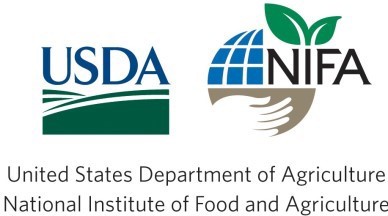 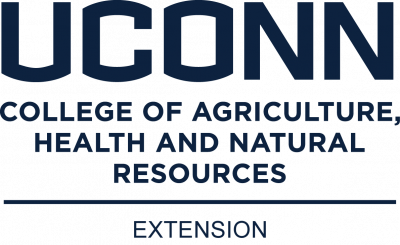 |